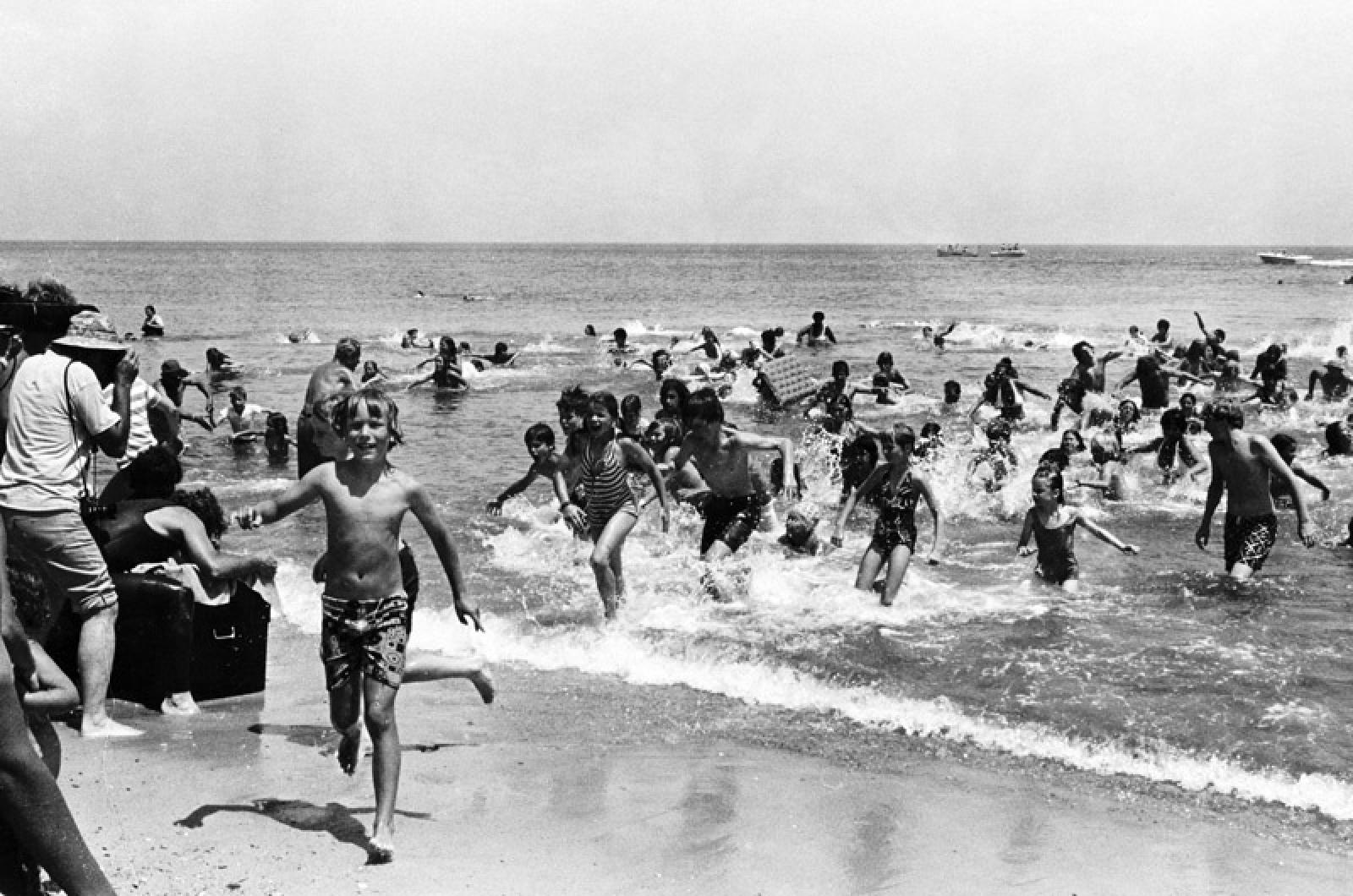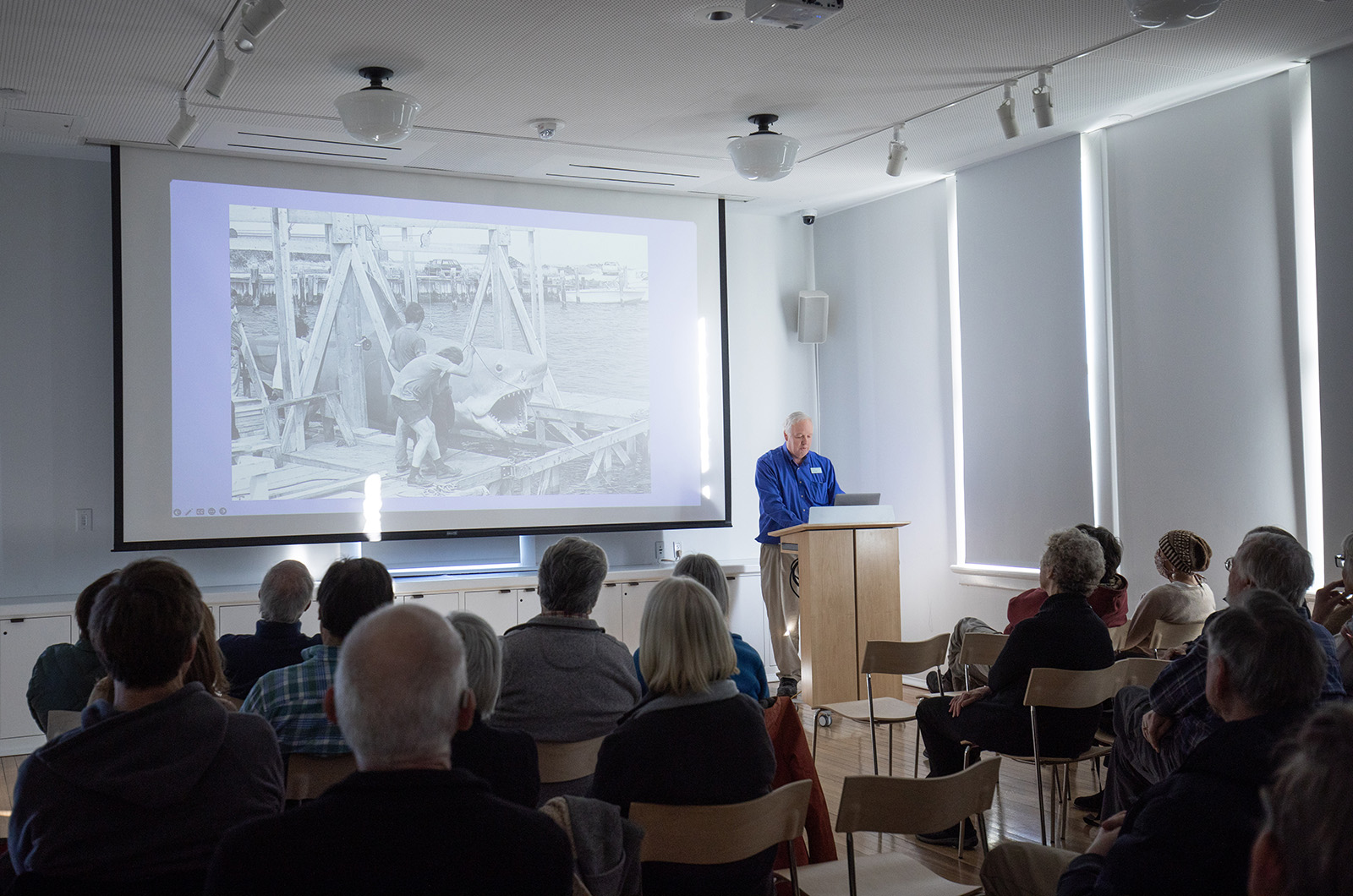Forty-nine years after young Hollywood director Steven Spielberg arrived on the Vineyard to make a scary movie about a people-eating shark, a new exhibition at the Martha’s Vineyard Museum looks back on the Island’s own starring role in Jaws.
Titled Creating Amity Island, the show brings together behind the scenes photos and collectibles from the now-historic 1974 production that made the Vineyard famous to millions of viewers around the world — and set Mr. Spielberg on his storied career.
“Had Jaws [failed], we would never have had E.T., Raiders of the Lost Ark, Schindler’s List,” research librarian Bow Van Riper said as he kicked off the year-long exhibition with a talk last week in the museum’s Morgan Learning Center.
And failure seemed a definite possibility during the film’s long-drawn-out production on Martha’s Vineyard.
“Prior to Jaws, virtually every major sea story to come out of Hollywood had its maritime scenes shot in a water tank, [because] in a water tank, you’re not at the mercy of the elements,” Mr. Van Riper said.
But Mr. Spielberg, still an emerging filmmaker in 1974 with just one feature and one made-for-television movie beneath his belt, wanted real open water for his adaptation of the best-selling Peter Benchley novel. Martha’s Vineyard offered the authenticity the director sought, said Mr. Van Riper, who is a scholar of film as well as of Island history.
“The Island... ultimately made the film what it was,” he said.
“Underneath the Amity drag, Edgartown was a real place,” Mr. Van Riper said. “Menemsha looks like a scruffy New England fishing village because it really is a scruffy New England fishing village.”
The Hollywood crew also encountered authentic New England weather, which was particularly stormy in the spring and summer of 1974, Mr. Van Riper said.
“They bought out [Edgartown chandleries] Norton and Easterbrook and Turf and Tackle’s entire stock of foul weather gear,” he said.
Along with rough weather, the filmmakers were bedeviled by technical delays as the mechanical shark at the heart of the movie’s mayhem — actually three sharks, to accommodate different camera angles — kept breaking down. But the shark’s unreliability spurred Mr. Spielberg to find other ways of terrifying his characters and viewers, Mr. Van Riper said, citing several well-known scenes and jump scares in which no shark appears.
It was a feat of craftsmanship that made Jaws a critical as well as a popular success, he said.
Mr. Van Riper began his talk, illustrated by vintage Gazette clippings and photographs, by setting the Island scene of early 1974. The Martha’s Vineyard Hospital and the Steamship Authority ferry Nantucket were brand new, the Island’s bike path network was years in the future and a turkey dinner at the VFW in Oak Bluffs cost $3.50 when Hollywood came to call, he said.
While the Chappaquiddick incident in 1969 had already drawn more visitors and attention to the Vineyard, he said, the release of Jaws in 1975 brought further change as moviegoers realized they could visit the Island they saw on the screen.
“The 70s were a watershed... a significant turning point in the Island’s relationship to the wider world,” he said.
Vineyarders also left their mark on Jaws, both on-screen and behind the scenes, Mr. Van Riper said. Film star Robert Shaw modeled his crusty shark-catcher Quint on Islander Craig Kingsbury. Chilmark resident Lynn Murphy, whom Mr. Van Riper described as a “homegrown practical genius engineer,” became a key technician.
Other extras and minor characters too numerous to mention fill the film’s crowd scenes, while Island actress Lee Fierro delivers star Roy Scheider a resonant slap in the face that Mr. Van Riper likened to Sidney Poitier’s famous scene slapping a plantation owner in In the Heat of the Night.
Offscreen, Gazette reporter and photographer Edith Blake chronicled the production, capturing Hollywood, locals and the shark for what would become her book On Location on Martha's Vineyard. Mr. Van Riper dedicated his talk to Ms. Blake, who died last month at 97.
Along with propelling Mr. Spielberg’s career, Jaws changed the movie industry in another way, Mr. Van Riper said. It was the first summer movie to open on screens across the country, creating immediate and massive word-of-mouth publicity.
“It made possible Star Wars [and] every big summer blockbuster of the last 50 years by being a screaming runaway success when it was premiered in the third week of June, 1975,” he said.
The museum’s current Jaws show is a preview of coming attractions, curator Bonnie Stacy told the audience at Mr. Van Riper’s talk. A full-on retrospective is coming in 2025 to mark the 50th anniversary of the film’s release, she said.











Comments (8)
Comments
Comment policy »